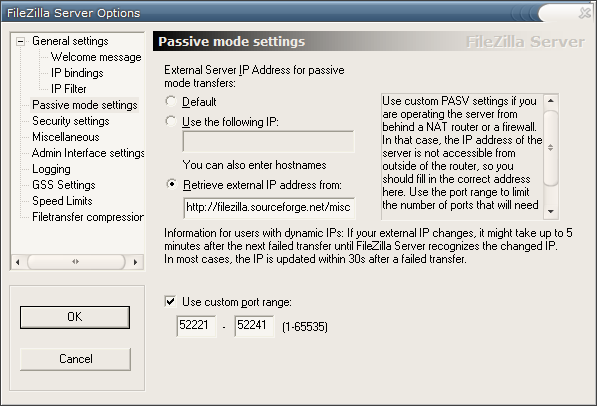
- #Filezilla server setup public ip how to#
- #Filezilla server setup public ip install#
- #Filezilla server setup public ip update#
For example, a user could connect by typing in. In order for others users to connect, you would need to provide them with the hostname you created on No-IP. Go back into FileZilla and enter your IP address in the box under ‘Use the following IP:’ and select OK.

For the purpose of this example, the IP address is 192.168.1.38. This will give you the IP address of your computer. Users can now connect to your server with the username and password you set on your FTP server. Outside of the application, open up Command Prompt on your computer and type in the following: ipconfig.
#Filezilla server setup public ip update#
This will remove the need for they Dynamic Update Client. Some devices that include No-IP for Dynamic DNS can be Routers or Camera systems. You can see if a device at your network supports for Dynamic DNS updates. This client will check your IP address every 5 minutes and if your IP has changed, it will automatically update that your hostname with No-IP. This client will need to be running at all times at the network’s location. You can download our free Dynamic Update Client. If you have a Dynamic IP address you will need to configure a way to keep No-IP up to date with your changing IP address.
#Filezilla server setup public ip how to#
If you are unsure how to port forward you can review our General Port Forwarding guide. You will need to open and forward port 21 on your router and any firewall you might use. Once the user has been created you can enable the account, as well as set a password for the user(s) you have created under the “Account Settings”, in the “General” sidebar. Enter the username you would like and select the group the user should be assigned to. Once the group has been created you will need to create a user by going to “Edit”, then “Users”, then “Add”. You can now create a group name and set the group permissions. To configure the groups in the FileZilla Server go to “Edit”, then “Groups”, then click “Add” under the group window. Once started you can now configure the FTP Server with different groups for the users. If you would like to set an administrative password, enter one now and click “OK”.

Once installed, the FileZilla server should open. If you do decide to change the port, make sure it is an uncommon port, generally 1024-65535.

I recommend leaving it at the standard port 14147. Typically (50000-51000) ports are used when transferring data to the server. You will see an option to choose what port the admin interface for FileZilla server should list. Then its necessary to set a passive mode port range.
#Filezilla server setup public ip install#
You will need to install the FileZilla server on your computer. You’ll first need to download the FileZilla server. There are a few different choices you can use to create an FTP server, but in this guide, we will use FileZilla, which is free. Once you have created a hostname on No-IP you will need to download and run an FTP server. If you do not already have an account, you will need to create an account by following the steps in our Getting Started guide. You can create and use a hostname with No-IP to run an FTP server. FTP or File Transfer Protocol servers allow you to share or host data on your computer that might be too large to transfer through an email.


 0 kommentar(er)
0 kommentar(er)
